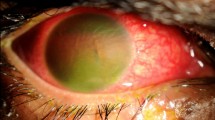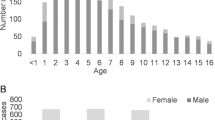Abstract
Purpose: The purpose of the study was to determine the causes, morbidity and visual outcome of 567 Intifada eye injuries which occurred during a 6 year period from December 1987 to December 1993.
Methods: A prospective study was undertaken of Intifada eye injuries from December 1987 to December 1993 which were treated at the St John Ophthalmic Hospital, Jerusalem, or in private clinics in East Jerusalem, the West Bank and Gaza.
Results: Seventy-five per cent of those injured came from East Jerusalem or the West Bank. The average age of a person injured was 17 years. Male preponderance was 84.7%. The study demonstrates both the high morbidity and the poor visual outcome which characterise Intifada eye injuries. There were 567 eyes in the series, of which 143 (25.2%) lost perception of light and 72 (12.6%) had vision less than or equal to 6/60. Eighty-six eyes (15.1%) required enucleation. In total 43.1% of the series had severe ocular injuries. Rubber or plastic bullets caused 154 injuries. They were the commonest indication for the enucleation of an eye (90.6% of 86 enucleations). There were 3 cases of severe Gram-negative endophthalmitis in the group of patients who presented late to the hospital (0.52%).
Conclusions: Intifada injuries are associated with far greater morbidity than non-military eye injuries. Rubber or plastic bullet injuries are the leading cause of visual loss and of eye enucleation. Military curfews exacerbate the morbidity of Intifada injuries by prolonging evacuation time.
Similar content being viewed by others
Article PDF
References
Jaouni ZM, O'Shea JG . Civilian eye casualties in East Jerusalem and the occupied territories. Medicine, Conflict and Survival 1996;12:138–48.
Hunter FA . The Palestinian uprising: a war by other means. London: IB Tauris, 1991:142–5.
Melman Y, Raviv D . Behind the uprising: Israelis, Jordanians and Palestinians. Westport, Conn.: Greenwood Press, 1989:1–15.
Playfair E . (ed.). International law and the administration of occupied territories. Oxford: Clarendon Press, 1992:1–85, 241-93, 443-57, 461-504.
Elder M . Penetrating eye injuries in children in the West Bank and Gaza Strip. Eye 1993;7:429–32.
Balouris CA . Rubber and plastic bullet injuries in Palestine. Lancet 1990;335:415.
Cohen MA . Plastic bullet injury to the face and jaws. S Afr Med J 1985;68:849–52.
Millar R, Rutherford WH, Johnson S, Malhotra VJ . Injuries caused by rubber bullets: a report on 90 patients. Br J Surg 1977;14:199–202.
Rocke L . Injuries caused by plastic bullets compared to those caused by rubber bullets. Lancet 1983;1:919–20.
Atmaca LS, Yilmaz M . Changes in the fundus caused by blunt ocular trauma. Ann Ophthalmol 1993;25:447–52.
O'Shea JG . Before and after: the contribution of ocular prosthetics at St John Jerusalem. The St John National (Australia) 1994;12 (May):3–4.
Koval R et al. The Israeli Ocular Injuries Study: A nationwide collaborative study. Arch Ophthalmol 1988;106:776–80.
Thylefors B . Epidemiological patterns of ocular trauma. Aust NZ J Ophthalmol 1992;20:95–8.
Parver LM, Dannenberg AL, Blacklow B, Fowler CJ, Brechner RJ, Tielsch JM . Characteristics and causes of penetrating eye injuries reported to the National Eye Trauma System Registry, 1985–91. Public Health Rep 1993;108:11–23.
Dannenberg AL, Parver LM, Fowler CJ . Penetrating eye injuries related to assault. The National Eye Trauma System Registry. Arch Ophthalmol 1992;110:849–52.
Scott R . British military surgery. J Trauma 1988;8:S83–5.
Author information
Authors and Affiliations
Corresponding author
Rights and permissions
About this article
Cite this article
Jaouni, Z., O'shea, J. Surgical management of ophthalmic trauma due to the Palestinian Intifada. Eye 11, 392–397 (1997). https://doi.org/10.1038/eye.1997.83
Issue Date:
DOI: https://doi.org/10.1038/eye.1997.83



